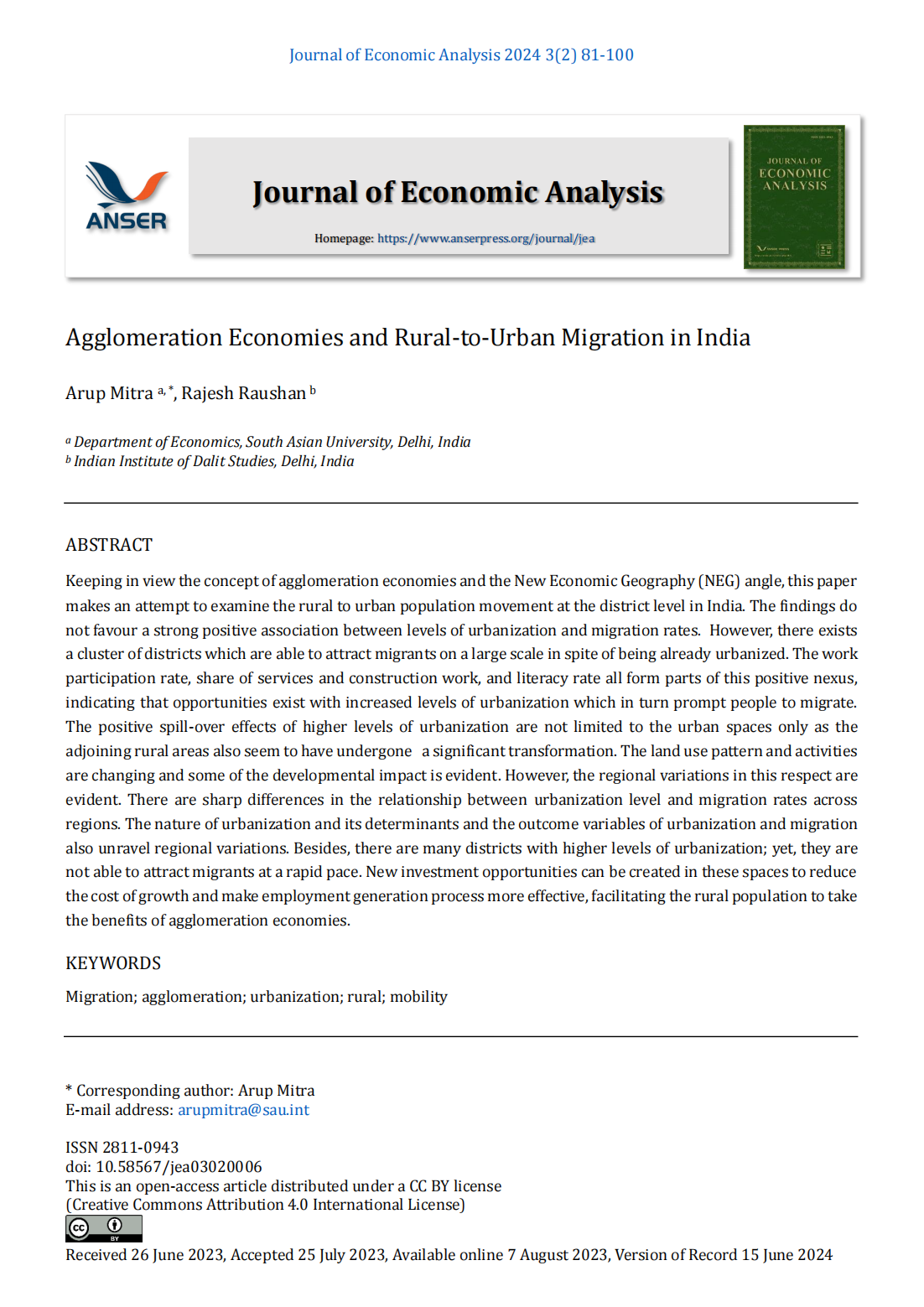Agglomeration Economies and Rural-to-Urban Migration in India
DOI:
https://doi.org/10.58567/jea03020006Keywords:
Migration; agglomeration; urbanization; rural; mobilityAbstract
Keeping in view the concept of agglomeration economies and the New Economic Geography (NEG) angle, this paper makes an attempt to examine the rural to urban population movement at the district level in India. The findings do not favour a strong positive association between levels of urbanization and migration rates. However, there exists a cluster of districts which are able to attract migrants on a large scale in spite of being already urbanized. The work participation rate, share of services and construction work, and literacy rate all form parts of this positive nexus, indicating that opportunities exist with increased levels of urbanization which in turn prompt people to migrate. The positive spill-over effects of higher levels of urbanization are not limited to the urban spaces only as the adjoining rural areas also seem to have undergone a significant transformation. The land use pattern and activities are changing and some of the developmental impact is evident. However, the regional variations in this respect are evident. There are sharp differences in the relationship between urbanization level and migration rates across regions. The nature of urbanization and its determinants and the outcome variables of urbanization and migration also unravel regional variations. Besides, there are many districts with higher levels of urbanization; yet, they are not able to attract migrants at a rapid pace. New investment opportunities can be created in these spaces to reduce the cost of growth and make employment generation process more effective, facilitating the rural population to take the benefits of agglomeration economies.
References
Ahrend, R., Farchy, E., Kaplanis, I., Lembcke, A. C. (2014). What Makes Cities More Productive? Evidence on the Role of Urban Governance from Five OECD Countries. OECD Regional Development Working Papers, no. 2014/05. OECD, Paris. https://doi.org/10.1787/20737009
Camagni, R., Capello, R., Caragliu, A. (2016). Static vs. Dynamic Agglomeration Economies: Spatial Context and Structural Evolution behind Urban Growth. Regional Science 95(1): 133–58. https://doi.org/10.1007/978-3-319-57807-1_12
Castells-Quintana, D., Royuela, V. (2017). Malthus Living in a Slum: Urban Concentration, Infrastructures and Economic Growth. Journal of Urban Economics, 98 (issue C), 158-173. https://doi.org/10.1016/j.jue.2016.02.003
Chen, C., Peng, S. (2020). New Economic Geography. Oxford Research Encyclopedias, Economics and Finance. https://doi.org/10.1093/acrefore/9780190625979.013.338
Duan, X., Yu, X., Lu, D., Nipper, J. (2010). The Study of New Economic Geography of Krugman and Its Significance. Acta Geographica Sinica, 65(2): 131-138.
Frick, S., Rodríguez-Pose, A. (2018). Big or Small Cities? On City Size and Economic Growth. Growth and Change, a Journal of Urban and Regional Policy 49(1): 4–32. https://doi.org/10.1111/grow.12232
Ghafoor, N., Mehru Nisa, Akbar, M. R. (2021). Socioeconomic Determinants of Migration in the City of Lahore, Pakistan. Journal of the Knowledge Economy, 13 (1). https://doi.org/10.1007/s13132-021-00844-4
Ghafoor, N., Fayyaz, S., Mehr-Un-Nisa, Poon, W. C. (2021). An empirical investigation of socio-economic impacts of agglomeration economies in major cities of Punjab, Pakistan. Cogent Economics and Finance, Volume 9 (1). https://doi.org/10.1080/23322039.2021.1975915
Haan, A., Brock, K., Coulibaly, N. (2002). Migration, Livelihoods and Institutions: Contrasting Patterns of Migration in Mali. Journal of Development Studies, 38(issue 5), 37-58. https://doi.org/10.1080/00220380412331322501
Hayami, Y., Dikshit, A. K., Mishra, S. N. (2006). Waste pickers and collectors in Delhi: Poverty and environment in an urban informal sector. Journal of Development Studies 42(1):41-69. https://doi.org/10.1080/00220380500356662
World Bank Group. (2019). Migration and Remittances. Brief, September 26.
Iversen, V., Sen, K., Verschoor, A., Dubey, A. (2009). Job recruitment networks and migration to cities in India. Journal of Development Studies,45(4), 522-543. https://doi.org/10.1080/00220380902725688
Kono, H. (2006) Employment with Connections: Negative Network Effects, Journal of Development Economics, 81 (1) pp. 244–258. https://doi.org/10.1016/j.jdeveco.2005.05.007
Krugman, P. (1991). Increasing Returns and Economic Geography. Journal of Political Economy, 99(3), 483-499. https://doi.org/10.1086/261763
Kundu, A. (2006). Urbanization and Urban Governance: Search for a Perspective beyond Neo-liberalism. In A. Shaw (ed.), Indian Cities in Transition. Hyderabad: Orient Longman. https://www.jstor.org/stable/4413810
Kundu, A., Mohanan, P. C. (2009). Poverty and Inequality Outcomes of Economic Growth in India: Focus on Employment Pattern during the Period of Structural Adjustment. OECD Seminar on ‘Employment Outcomes and Inequality: New Evidence, Links and Policy Responses in Brazil, China and India’, 8 April, Paris.
Lang, C., Pott, A., Shinozaki, K. (2021). Organisations and the Production of Migration and in/Exclusion. Comparative Migration Studies, 9:60. https://doi.org/10.1186/s40878-021-00274-w
Mills, E. S., Becker, C. M. (1986). Studies in Indian Urban Development. Oxford University Press.
Mitra, A., Murayama, M. (2009). Rural to Urban Migration: A District‐Level Analysis for India. International Journal of Migration, Health and Social Care, Vol. 5(2). https://doi.org/10.1108/17479894200900011
Mitra, A., Nagar, J.P. (2018). City size, deprivation and other indicators of development: Evidence from India. World Development, 106, 273-283. https://doi.org/10.1016/j.worlddev.2018.02.018
Munshi, K. (2016). Community Networks and Migration. In Y. Bramoullé, A22. Galeotti, and B. W. Rogers(ed.), The Oxford Handbook of the Economics of Networks. https://doi.org/10.1093/oxfordhb/9780199948277.013.29
Ottaviano, G., Thisse, J. F. (2004). ‘Agglomeration and Economic Geography’. In J. V. Henderson and J. F. Thisse (eds), Handbook of Regional and Urban Economics, vol. 4, 2120–71. Amsterdam: Elsevier B V.
Rajan, S. I. (2013). India Migration Report 2013: Social Costs of Migration. Routledge India.
Rajan, S. I. (2020). COVID-19-led Migrant Crisis: A Critique of Policies. Economic and Political Weekly, 55(48).
Roca, J., Puga, D. (2017). Learning by Working in Big Cities. The Review of Economic Studies, Volume 84, Issue 1, January, 106–142. https://doi.org/10.1093/restud/rdw031
Srivastava, R. (2020). Understanding Circular Migration in India: Its Nature and Dimensions, the Crisis under Lockdown and the Response of the State. WP 04/2020 Centre for Employment Studies Working Paper Series, Institute for Human Development, Delhi.
Wan, G., Lu, M. (2019). Cities of Dragons and Elephants. Oxford University Press, Oxford.
Yang, Y., Lu, X., Chen, J., Li, N. (2022). Factor Mobility, Transportation, Network and Green Economic Growth of the Urban Agglomeration. Scientific Reports, 12, 20094. https://doi.org/10.1038/s41598-022-24624-5

Downloads
Published
How to Cite
Issue
Section
License
Copyright (c) 2024 Arup Mitra, Rajesh Raushan

This work is licensed under a Creative Commons Attribution 4.0 International License.



